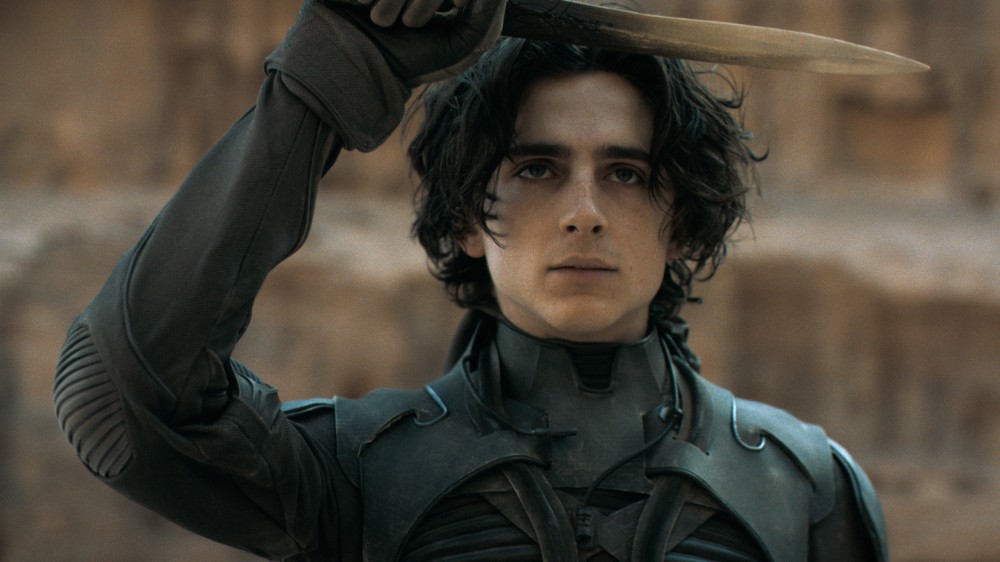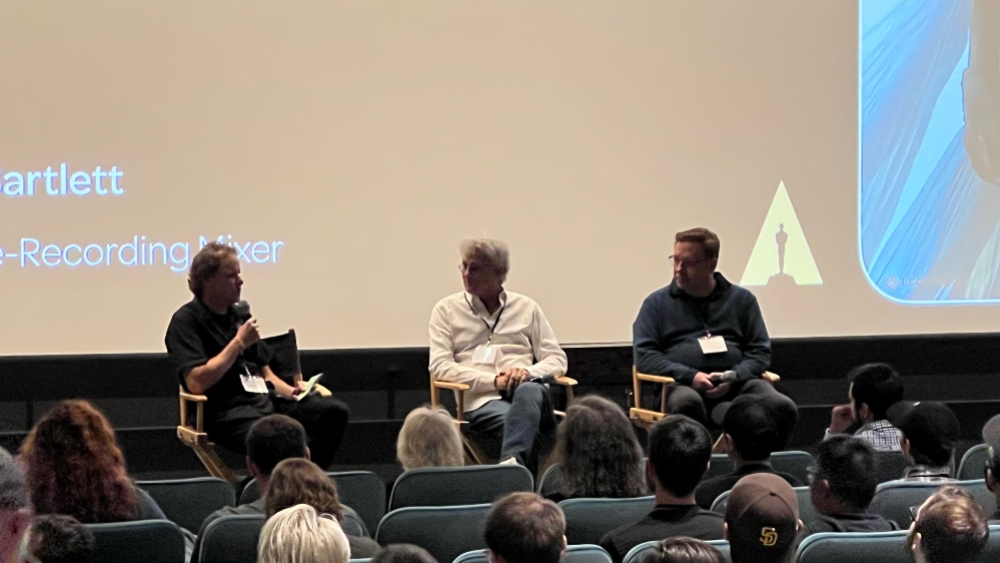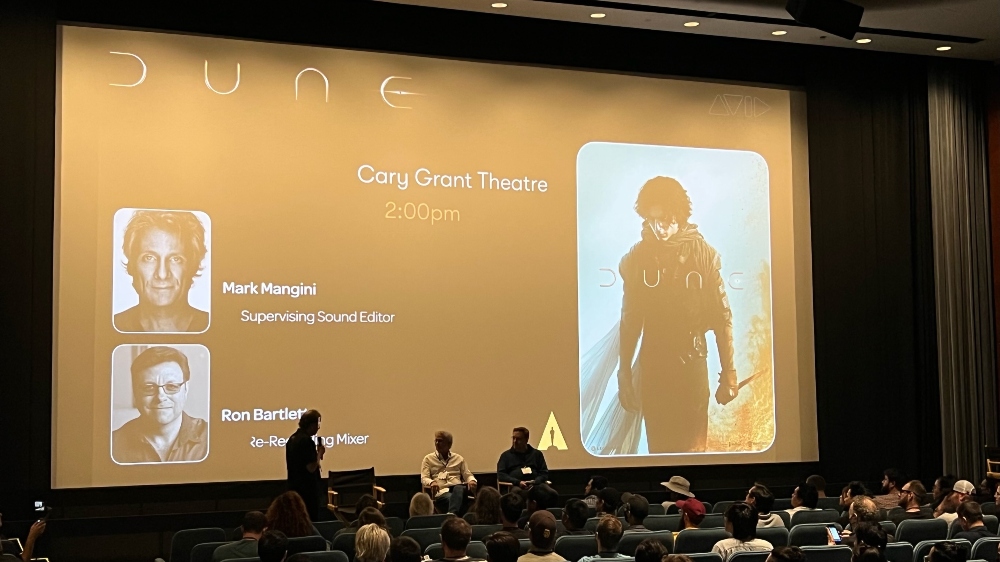
Despite a day-and-date release on HBO Max, Dune: Part One was a box office success, surpassing $400 million in global ticket sales en route to winning six Academy Awards. Its haul included an Oscar for Best Sound, won by Supervising Sound Editor Mark A. Mangini, Re-Recording Mixers Ron Bartlett and Doug Hemphill, Sound Mixer Mac Ruth, and Sound Designer/Supervising Sound Editor Theo Green.
At Mix magazine’s annual Sound for Film & TV confab on the Sony lot, Mangini and Bartlett detailed their work on the movie in a conversation moderated by Avid product specialist Jeff Komar, who pointed out that Komar, Mangini, and Bartlett had previously worked with Villeneuve on Blade Runner 2049 (released in 2017).
“Did [that experience give] you a better idea of his aesthetic and how he values sound?” asked Komar.
Mangini said that they “developed a shorthand working on Blade Runner.” “We learned many vital things,” he said. “Although what I do — sound design and sound editorial — is considered to be post-production, Denis always considered sound to be an integrated part of the shoot all the way until it becomes post-production.”
Mangini noted that he and Green “develop sounds during production… often driving portions of the edit.” “We learned that on Blade Runner and brought it to Dune,” he added.
“Denis loves to allow us to fail,” explained Bartlett. “If we try something, swinging for the fences, he might say, ‘it’s really cool, but not in my movie.’ It teaches you where you can go — maybe all the way, but then dial it back or go in another direction. That was a wonderful thing we discovered on Blade Runner and went for with Dune.”
Mangini said the sound is planned early on, first by “deciding an overriding sound ethos.”
“Denis said to us that he wanted the movie to sound as if a documentary film crew was dropped on the planet and the sounds could be captured with a boom pole. To that end, Theo and I adopted FDR — Fake Documentary Realism — and that was the filter through which all the sound was heard. If it didn’t fit that ethos, it wasn’t in the film, so we didn’t use anything synthetic that didn’t happen in an acoustic space. We devised 3,200 original sounds and only three were not originated organically,” he said.
Mangini then recounted an anecdote about the creation of one of the movie’s few synthetic sounds, for the shields.
“In science fiction, it says that if there’s a forcefield, you should see it and hear it,” he said. “But Theo and I were dead set against doing what we thought was a trope.”
In what Bartlett called “an experiment gone bad,” he recounted that Theo’s computer made a strange sound that he captured. “Theo saw the value in [that sound] and cut it in when the forcefield hit the shield. That showed us the way out of the problem. As that idea developed, those initial sounds would go on the strike [to the shield] and hold for eight seconds, with VFX adding a glow. Then we added a stutter, and VFX added a stutter also,” he said.
“This was happening before post-production even started,” added Bartlett. “This is a beautiful way to do it. Sound should be considered as an organic part of the production process.”

Mangini added that on Blade Runner, “Denis said he wanted us to compose with sound.” (Hans Zimmer was the film’s composer.) “That meant that Theo, Ron, and I brought a musical sensibility that doesn’t necessarily mean melody, but the other aesthetics a composer brings to a movie,” he said. “We always wanted sound and music to overlap so you wouldn’t see the joints [between them].”
Bartlett noted that on both movies, they “really exploited the spaces.” “On Dune, I used delays going into reverbs to try new things,” he said. “The film lent itself to that. You can talk plugins until you’re blue in the face, but it’s how it affects you as a listener — what matters is what we did to make you feel a certain way.”
Komar asked the panel to explain their approach to Dolby Atmos.
“It’s not just the giant screen anymore,” said Bartlett. “This is the pinnacle of what you can do with sound.” He revealed that the sound team and Villeneuve had a long talk about using Surround Sound on Blade Runner, but the director said he didn’t like it. “Then later, he said, ‘I really love Atmos.'”
On Dune, Bartlett said, he “had so many tracks to play with.” “It started small but got bigger as I had ideas,” he explained. “Denis is very much a concept guy. He’ll tell you what he wants out of the scene — and you go get it. Or he can also be a ‘show me’ guy. I could try things out and ask him what he thinks, so we’re showing him, not talking about it. He really has you bring your A-game.”
Komar also noted that “the dialogue is immaculate — crystal clear and audible.” Bartlett stated that “Denis was adamant about hearing everything well.” “I clean up the dialogue, EQ it, compression, all the normal things I mix with clip gain to get every syllable heard and balanced,” he said. “With sound design, it piles up. Everyone wants to be heard but we’ll mute it or push it out of the way. We call them gray sounds that aren’t useful to us. It’s our job to create that clarity and depth for the audience.”
Bartlett thanked Komar for Avid adding clip gain, something, he said, “we use all the time.” With regard to sound design elements, Mangini reported that Villeneuve encouraged the team to pitch their ideas and approved every design element and most of the music before post-production began.
Mangini and Bartlett then walked through the sonic creation of a handful of scenes, including when the Reverend Mother Gaius Helen Mohiam (Charlotte Rampling) tests Paul Atreides (Timothée Chalamet) by placing his hand in a box and holding a poison-tipped needle to his throat. Explaining that he will die if he removes his hand from the box, she emits an excruciatingly painful high-pitched sound — the “voice” used as mind-control.

“The voice itself was our most complex task,” explained Mangini. “It took 16 months to finish in the mix and [it] was the hardest thing for Theo to design. To leverage the voice as a weapon, Mother Mohiam must summon the strength of the ancestors. We didn’t want to put a filter on the voice or a cocktail of plugins — we wanted story-related ideas. So we brought in the voices of the ancestors by recording a group of authoritative women, and we hear their ‘witchy’ voices throughout the room.” He added that they thought “it would be cool to also pull the oxygen out of the room.” “You didn’t hear it, but felt it,” he said.
Bartlett added that “the beauty in that scene is from room tone.” “It gets sucked out to the high point of the sound,” he said. “You don’t want to get there too fast but keep teasing people in anticipation of what’s coming.” In building up the sound and score, they used everything from dentist drills to guitars. “It was a symbiotic relationship between me and Doug,” he added. Zimmer’s score included Tuvan throat singing, creating “cool layers of chanting” that were spread out throughout this section.
The rescue of Paul Atreides is Bartlett’s favorite sonic scene in the movie. “There are small sounds, giant sounds, both at the same time and everything in between,” he said. “It’s real storytelling, with sound yanking you around and the score is so epic. It was really fun to mix.”
Mangini recounted that the team went out multiple times to the desert to record sounds.
“Apropos of FDR (fake documentary realism), I was trying to design the sound of a 400-meter-long worm sucking a Harvester into its maw,” he said.
In addition to all the desert recordings, Bartlett said Hemphill came up with ideas such as using the sounds of ocean waves for the sand rippling sounds. “When the big cloud of sand washes over Paul, that was Doug, filtering it with a live cue,” he said. “It was him performing it live.”
Mangini noted that he also made “a big growling sound” as one of the elements of the wormhole. “You can’t move enough sand for the epic sound we needed.”
Komar later asked Bartlett and Mangini to talk about how they exchanged and managed all the sound assets.
“Avid’s ProTools and a shared server system at the studio,” answered Mangini. “I design sound, record it, populate a ProTools session, and hand that off. When Reel 1 is done, I have a typical review session and we have a Dewey decimal system to keep track of the latest iteration.” He added that “the way Doug and I work, we don’t bring materials and import into another environment.” “We coordinated the plugins that people wanted to use, where they went, how many PCAs [Principal Component Analysis]. All that is pre-determined in the earliest stages of sound design and then dropped into a ProTools session.”
Bartlett stated that he “gave [the team] a template for dialogue very early on as well.” “You just keep carrying these things forward,” he said. He also revealed that due in part due to COVID restrictions, he mixed the entire score in his home studio, which was outfitted with Dolby Atmos. “It was fun and so intimate,” he said. “That’s where we really found the voice of the music and where it fit in. And it translated very well when we finally went back to Warner Bros.”
For more coverage of the Sound for Film & TV event, click here and here, and click here for coverage of The Batman panel.





